Abstract
In a revolutionary study published in the Proceedings of the National Academy of Sciences (PNAS), researchers from IBM Research-Zurich and the Technion-Israel Institute of Technology present a groundbreaking technology that promises to redefine microscale fluid manipulation. Their work, titled “Dynamic microscale flow patterning using electrical modulation of zeta potential,” introduces a novel mechanism for crafting intricate flow patterns on microscales using solid-state actuation. This development is seen as a key enabler for a plethora of on-chip applications, bringing us one step closer to the much anticipated lab-on-a-chip revolution.
Introduction
Microfluidic platforms have seduced the scientific community with their potential to transform biological assays, chemical reactions, and even mechanical processing by miniaturizing and integrating complex laboratory procedures onto a single chip. As such, evolutions in this field hold the promise of revolutionizing biomedical diagnostics, pharmacological screenings, and environmental monitoring. Historically, manipulating fluids at such diminutive scales has been shackled by rigid physical barriers – generally channels carved into substrates and operated by mechanical valves. However, a new study published in PNAS by researchers Paratore et al. [1] envisions an alternative future unaffected by the limitations of fixed geometries.
The Breakthrough
Building on past explorations of Hele-Shaw cell electrokinetics and electroosmotic flows [2][3], the team focused their mastery on manipulating zeta potential – the electrical charge at the interface where the fluid and the channel surface interact. By deftly managing a group of gate electrodes via alternating current (AC) voltage, the researchers successfully conjured complex and hitherto unimagined flow patterns within a simple fluidic chamber devoid of traditional channels.
These patterns included quiescent zones amidst turbulent flows and vortices of stagnation in dynamic fluids. This unprecedented degree of control over fluid movement was achieved through cleverly arranged gate electrodes subjected to electrical modulation, dictating both speed and direction of the electroosmotic flows [4].
Applications and Potential
The epitome of elegance in design, this new approach, employing solid-state actuation to orchestrate flow patterns of varying complexity, portends the dawn of new functionalities for on-chip devices. The implications are colossal – from enhancing the mixing of reagents for chemical analyses to on-demand generation of fluidic pathways for biomedical assays. This technology could be a linchpin in effectuating lab-on-a-chip systems that are more versatile, adaptable, and powerful than those seen today [5].
The use of electrical modulation of zeta potential to sculpt flow patterns situates itself as a preeminent tool in the rapidly evolving realm of microfluidics. Its potential applications resonate well beyond basic scientific interest, touching upon domains like energy conversion [6], high throughput screening, and even the creation of artificial biomimetic systems.
Characterization and Guidelines
Bearing in mind the need for practicable applications, the study does not merely bask in academic theory but also addresses the system’s time response and durability by assessing dielectric breakdown. The inclusion of robust engineering guidelines guarantees that this elegant methodology, whilst sophisticated in concept, is not a distant dream but an accessible reality with an actionable roadmap towards implementation [7].
Conclusion
What we are witnessing here is not just an incremental progress in the world of microfluidics, but a paradigm shift that stands to redefine the boundaries of the possible. With the shackles of conventional channel-based fluidics being discarded in favor of a more versatile, non-conventional approach, the future of lab-on-a-chip technologies looks brighter than ever.
Would this be the moment that turns the tide, catapulting microfluidic technology from a promising prospect into a ubiquitous reality across industries? Only time will tell.
References
1. Paratore, F., Bacheva, V., Kaigala, G. V., & Bercovici, M. (2019). Dynamic microscale flow patterning using electrical modulation of zeta potential. Proceedings of the National Academy of Sciences, 116(21), 10258-10263. doi: 10.1073/pnas.1821269116
2. Stone, H. A., Stroock, A. D., & Ajdari, A. (2004). Engineering flows in small devices: Microfluidics toward a lab-on-a-chip. Annu Rev Fluid Mech, 36, 381–411.
3. Psaltis, D., Quake, S. R., & Yang, C. (2006). Developing optofluidic technology through the fusion of microfluidics and optics. Nature, 442, 381–386.
4. Boyko, E., Rubin, S., Gat, A. D., & Bercovici, M. (2015). Flow patterning in Hele-Shaw configurations using non-uniform electro-osmotic slip. Phys Fluids, 27, 102001.
5. Nguyen, N.-T. (2010). Micro-optofluidic lenses: A review. Biomicrofluidics, 4, 031501.
6. Chen, X., Xu, B., & Liu, L. (2014). Nanoscale fluid mechanics and energy conversion. Appl Mech Rev, 66, 050803.
7. Choi, K., Ng, A. H. C., Fobel, R., & Wheeler, A. R. (2012). Digital microfluidics. Annu Rev Anal Chem, 5, 413–440.
Keywords
1. Microfluidic Control
2. Electroosmotic Flow
3. Lab-on-a-Chip Technology
4. Dynamic Flow Patterning
5. Solid-State Actuation
